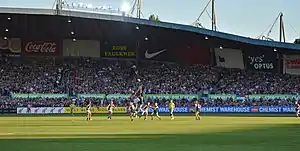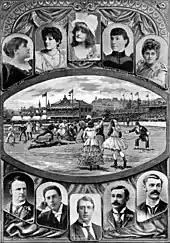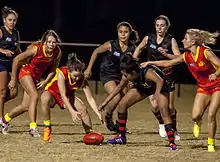Women's Australian rules football
Women's Australian rules football, also known simply as women's football or women's footy, is a form of Australian rules football played by women, generally with some modification to the laws of the game.

Women's football began to be organised in the early 20th century, but for several decades occurred mostly in the form of scratch matches and one-off exhibition games. State-based leagues emerged in the 1980s, with the Victorian Women's Football League (VWFL) forming in Melbourne in 1981 and the West Australian Women's Football League (WAWFL) forming in Perth in 1988. The AFL Women's National Championships were inaugurated in 1992. Women's football became professionalised in the 2010s, with a national league, AFL Women's, commencing its inaugural season in 2017 with teams formed by existing Australian Football League (AFL) clubs.
History

Codified in 1859, Australian football had been played by men for almost half a century before the first women's football matches were played. Contact sports such as football were widely considered unsuitable for women at the time, and public attitudes prevented them from participating in organised matches. Exceptions included charity matches, such as patriotic fundraisers, which occasionally featured women players. Women have nonetheless followed the Australian game passionately since the mid-19th century, comprising approximately 50% of spectators at matches—a uniquely high figure among football codes.
Both world wars were a great liberator for women; as the men fought in the war, women were often called to perform many tasks typically done by men, including spectator sports. Records exist of a football side in Perth, Western Australia made up of department store staff playing as Foy & Gibson's as early as 1917.[1] Matches played in Western Australia were also recorded in 1918.[2] In South Australia, an early example of Women's football was a Port Adelaide Women's team in 1918 where a game took place at Alberton Oval between Port Adelaide and another club representing Thebarton. Port Adelaide was captained by Eileen Rend.[3]
Following World War I, an exhibition match in Melbourne was held to show that women could play what had previously been seen to be a man's sport. The first women's match attracted a large crowd and interest. The umpire wore a dress.[4]

In 1929, as part of an annual charity day, a 30 minute match was played on Adelaide Oval between workers of the Charles Moore & Co. factory and the Mirror Shirt and Pyjama Factory. Although the match was not a standalone event newspapers at the time did refer to it as the main attraction of the day. A moth biplane dropped the game ball to start the match.[5]
Archives also show a charity women's match occurred on Bassendean Oval in Perth, Western Australia, 27 August 1944.[6] It is unknown whether the game had been played continuously in the state. [5] Beyond this and occasional matches over the years, women's football was rarely organised, until the formation of the Victorian Women's Football League in 1981 with four teams competing at open level.
Women's Australian rules football began to rapidly grow in 2000, with the number of registered teams increasing by a phenomenal 450%.[7]
In women's Australian rules football in 2015, 163 new teams were formed and a total of 284,501 players took part in organised games.[8]
The first full international was held between the USA Freedom and Team Canada in Vancouver on Saturday 4 August 2007 in front of a crowd of almost 2,500.[9][10][11]
Rule modifications
Some women's competitions, but not all, are played with modified rules.[12]
The main rule differences between the women's and men's versions of Australian football involves modified tackling rules. Typically aggressive slinging (swinging a player by the jumper or throwing the player to the ground) of oppositions players in a tackle is not allowed. Like the men's game, head high contact is strictly not allowed.
Another main difference is the size of the ball. A smaller ball to the men's version is often used to minimise hand injuries when (marking) the ball.
Games of International rules football are also played by many women's leagues against Gaelic Athletic Association clubs. Recreational football, a fully non-contact version of Australian rules football, is also becoming popular amongst women in Australia and the United States. Many women's leagues also fall into the emerging 9-a-side footy or Metro footy formats.
Competitions
National league
A national competition backed by the AFL began in 2017. Bids for a licence to participate were submitted by 13 existing AFL teams, with eight teams awarded licences to participate in the inaugural season.
The competition had been announced in 2008 and was slated to commence in 2013 with four to eight teams, but this was later postponed after it was found that the new teams from the Gold Coast and Greater Western Sydney would not have time to submit their bids in full.[13]
A licence was granted to Fremantle under the umbrella of the Women's Football League in February 2010, but due to a review and the subsequent admission of the Gold Coast and Greater Western Sydney to the AFL, this licence was recalled. With the foundation of the AFLW in 2017, this licence was reissued to the club.
National championships
Women's Football Australia are responsible for the annual AFL National Women's Championships which began in 1992. In 2005, two teams from Victoria, a senior and an under-19s side and teams from the ACT, Northern Territory, New South Wales, South Australia, Western Australia, the Australian Defence Force and Queensland participated.
International competition

There was a women's division at the 2008 Australian Football International Cup with Australia, US, Canada and Papua New Guinea competing. There is also International Rules Football with a women's Australia women's international rules football team competing against the Ireland women's international rules football team.[14][15] The 2006 tour helped to lift the profile of the sport slightly in Australia.[16]
The first ever full international was held between the US "Freedom" and Team Canada in Vancouver on Saturday 4 August 2007.[9][10] The US Freedom toured Australia in August 2009 playing teams in Sydney, Cairns, Bendigo, and Melbourne over an 8-day period.
Papua New Guinea's national team, the "Kurakums" competes in the AFL Women's National Championships.[17]
Participation figures
During the 1970s, 1980s and 1990s, women's Australian rules football saw a large expansion in the number of competitors.[18] In 1998, Auskick, a national program began. The program was designed to introduce the game to primary school aged children. By 2006, it had over 140,000 participants each year. Though the program was never specifically aimed at girls, the safe non-contact environment proved popular and in 2007 about 16% (12%) in of all Auskick participants were female.
In Australia, a total of 18,609 girls and women played Australian rules football in 2005 and in 2006 48,054 women played the sport in Australia, and it is one of the fastest growing sports among women in Australia.[19]
By 2017, a record number of 463,364 females were playing Australian rules football across the nation, making up 30% of all participants. The number of female Australian Rules Football teams reached 1,690 nationally, a huge 76% increase on the previous year [20]
By region
Australia
There are women's Australian rules football teams in all states and territories of Australia.
Victoria
.jpg.webp)
Organised women's Australian rules football has been played in Victoria since 1981 with the formation of the Victorian Women's Football League (VWFL), the oldest and largest Australian rules football league for women in the world.
Women's football in Victoria has a comparatively high profile in the media. The work done by League president Debbie Lee and Media Manager Leesa Catto as well as involvement by celebrities such as Tiffany Cherry have helped to boost exposure for the sport. The VWFL Grand Final is now played in front of a crowd exceeding 1,500 people. The annual Vic Country vs Vic Metro match has been now played as a curtain raiser to a home and away Australian Football League match at the Melbourne Cricket Ground. VWFL players have participated in charity matches against senior male players in both the AFL Legends Game (which is broadcast on television in multiple states and live in Victoria)[21][22] and Community Cup.[23]
The VWFL is an open age Women's Footy competition which began in 1981 with four teams. In the following decades it has grown substantially and now features 3 division structure and as well as many clubs fielding teams in the reserve grades for the first and second division. In 2004 the League affiliated with Football Victoria. In 2005 there were 24 teams (from 20 clubs) in total, with over 800 women taking part.
A U17 Youth Girls Competition was established by Football Victoria in 2004. This was following legal action taken against them in the Victorian Civil and Administrative Tribunal (following a complaint to the Equal Opportunity Commission) by Penny Cula-Reid, Emily Stayner, and Helen Taylor.[24] The three schoolgirls were banned from playing in junior leagues, with fears of expensive insurance liability in case of injury and "medical reasons" being cited by Football Victoria (i.e. the physical differences between the bodies of boys and girls). The court found in favour of the girls in February 2004. In response to the ruling, the U17 Youth Girls Competition began in May, with 122 girls participating.
Victoria fields both senior and under 19 in the AFL Women's National championships and have been the dominant state, with the two teams combined having won every one of the 15 national titles. [25]
Western Australia
Organised Women's Australian rules football has been played in Western Australia since 1988, with the first premiership being won by Mount Lawley. Although it has less clubs than Queensland, Western Australia is considered the strongest women's state outside of Victoria. The strongest clubs are in Perth.
South Australia
In 1990 a group of South Australian women helped instigate exhibition match between a South Australian side and the Victorian Women's Football League. The success of the match saw the formation of the SAWFL for the next season. The clubs are centred in Adelaide.
New South Wales
The Sydney Women's AFL competition is the only organised women's football in New South Wales. It has been running since 2000 and has grown substantially in popularity. Centred on metropolitan Sydney it has two divisions and 12 clubs in 2013. In 2015, the Black Diamond AFL commenced its inaugural women's competition in the Newcastle and Central Coast regions. Six clubs participated in the inaugural season (Maitland, Newcastle City, Nelson Bay, Warners Bay, Lake Macquarie and Wyong Lakes), with Newcastle City defeating Nelson Bay by 22 points in the Grand Final to claim the first BDAFL Women's premiership. The competition expanded to ten clubs in 2016 with teams from Singleton, Cardiff, Killarney Vale and Gosford entering teams. Nelson Bay avenged their 2015 heartbreak with an undefeated season culminating in a 3-point win over Newcastle City in the Grand Final. The competition continues to gain momentum with hopes of a second division being created in the near future.
Queensland

There are leagues centred in South-East Queensland and Central Queensland, and the cities of Cairns, Townsville, and Mackay.
Northern Territory
Australian Capital Territory
Tasmania
Africa
AFL South Africa runs a junior program which includes girls in mixed competition. There are plans for a junior girls' league in the North West Province.[26]
Americas
Organised women's football is played in the United States (organised by the Women's Australian Football Association) and Canada (organised by the Canada Women's Australian Football League). The first match in the United States was played in Kansas City in October 2003. A women's division was introduced to the USAFL National Championships in 2005.[27] Both the U.S. national team (known as the USA Freedom) and the Canadian national team (known as the Northern Lights) have played in the Australian Football International Cup. Outside of those countries, an under-19s championship with male and female divisions was held in Argentina in 2007.[28]
Asia-Pacific
The Canterbury AFL in Christchurch played the first official women's football match in New Zealand late in 2006.[29]
Also in 2006, AFL PNG (the sport's governing body in Papua New Guinea announced their first women's team (Under 16s) to take part in the Australian national women's tournament.[30] It is estimated that there are around 200 women's Australian rules footballers in PNG.[31]
In Japan, Australian rules football is played in many universities. Women's footy is played by the Tokyo Geckos, the Irish Galahs (Gaelic football) and Osaka Bilbies.[32]
Europe
The first ever women's footy match in the UK was organised by Aussie Rules UK and was held in London on 21 April 2007 as part of the ANZAC Sports Challenge. Since then, women's Australian rules football teams have been formed across Europe, with women's teams representing England, Ireland, Scotland, France, Sweden, Croatia, and a combined Wales/Denmark team competing at the 2017 Australian Rules Football European championship, known as the Euro Cup.[33] There is a women's league in London, founded in 2015, which currently consists of teams from 7 clubs across two divisions.[34]
There are also University-based women's Australian rules football teams across Europe, such as at the Universities of Cork, Birmingham, Oxford, and Cambridge. The University of Oxford founded a women's team in 2015, with the University of Cambridge following in 2017. After more than 100 years since the first recorded men's Oxford versus Cambridge Australian rules football varsity match (as reported in the Kalgoorlie Miner newspaper in 1911) the first women's Australian rules varsity match was played in Oxford in March 2018 and resulted in a draw.
LGBTI issues
In September 2017 the AFL ruled that transgender woman, Hannah Mouncey, was ineligible for selection in the 2018 AFLW draft.[35] There was opposition to the AFL's decision,[36][37] and she can continue to play for her Canberra club.[38]
See also
- List of Australian rules football women's leagues
- List of International Australian rules football Tournaments
- AFL Women's National Championships
- International rules football
- Rec Footy
- 9-a-side footy
- Touch Aussie Rules
- Kick-to-kick
- Australian rules football
- Metro Footy
- Women's sports
References
- "Foy & Gibson women's football team". 1 January 1917 – via innopac.slwa.wa.gov.au Library Catalog.
- "Photographic image of 1915 Girls' Football Match in Perth, Western Australia". Innopac.slwa.wa.gov.au. Retrieved 19 October 2016.
- "LADIES' FOOTBALL MATCH". Port Adelaide News. 6 (12). South Australia. 1 November 1918. p. 1. Retrieved 14 February 2017 – via National Library of Australia.
- AFL Record. Round 19 (Women's Round), 2007. Pg 8
- "News (Adelaide, SA : 1923 - 1954) - 8 Aug 1929 - p17". Trove. Retrieved 22 December 2020.
- "Photographic image of Women's Football Match, Western Australia". Innopac.slwa.wa.gov.au. Retrieved 19 October 2016.
- "Women in a league of their own - realfooty.com.au". Theage.com.au. 31 May 2003. Retrieved 19 October 2016.
- "Women's participation soars in 2015". AFL.com.au. Retrieved 19 October 2016.
- Brett Northey. "Women's international footy - Canada versus USA". World Footy News. Retrieved 19 October 2016.
- Christopher P. Adams, Ph.D. "US Freedom dominate in first women's international". World Footy News. Retrieved 19 October 2016.
- Brett Northey. "North American women's footy on SEN". World Footy News. Retrieved 19 October 2016.
- "Newtown Breakaways | Resources". Cd.com.au. 20 June 2014. Archived from the original on 20 August 2008. Retrieved 19 October 2016.
- "Review could lead to AFL women's league". News.smh.com.au. Retrieved 19 October 2016.
- Sean Finlayson. "Brave Aussie ladies like ewes to the slaughter in Ireland". World Footy News. Retrieved 19 October 2016.
- Peter Parry. "International Rules series for the Ladies/Women". World Footy News. Retrieved 19 October 2016.
- "Women join in changing rules - Sport". Theage.com.au. 14 October 2006. Retrieved 19 October 2016.
- "Archived copy". Archived from the original on 27 September 2007. Retrieved 2007-07-26.CS1 maint: archived copy as title (link)
- Stell, Marion K. (1991). Half the Race, A history of Australian women in sport. North Ryde, Australia: Harper Collins. p. 252. ISBN 0-207-16971-3.
- "AFL News, Scores, Stats, Transfers – Real Footy". The Age. Melbourne, Australia.
- "Huge spike in women's footy participation figures tells revealing story". The Guardian. Melbourne, Australia.
- "Men v women: ratings winner - Sport". Theage.com.au. 8 June 2007. Retrieved 19 October 2016.
- "Archived copy". Archived from the original on 28 September 2007. Retrieved 2007-08-02.CS1 maint: archived copy as title (link)
- "Rockers roll disc jocks in a game called, charitably, football - National". Theage.com.au. 24 June 2007. Retrieved 19 October 2016.
- "Vic girls take AFL fight to court - ABC News (Australian Broadcasting Corporation)". Abc.net.au. 10 November 2003. Retrieved 19 October 2016.
- "AFL News | Read the Latest Footy News". Real Footy. Retrieved 19 October 2016.
- Brett Northey. "Out of Africa - and back - Allison's football journey". World Footy News. Retrieved 19 October 2016.
- Ash Nugent. "Footy in Argentina still kicking". World Footy News. Retrieved 19 October 2016.
- Brett Northey. "Women's Footy starts in Canterbury NZ". World Footy News. Retrieved 19 October 2016.
- Brett Northey. "PNG girls set to travel". World Footy News. Retrieved 19 October 2016.
- Rod Shaw. "Kurakums of PNG - showcasing international women's football". World Footy News. Retrieved 19 October 2016.
- afleurope (28 September 2017). "Euro Cup 2017 Fixtures • AFL Europe". AFL Europe. Retrieved 22 December 2020.
- "afllondon". AFL London. Retrieved 22 December 2020.
- "Transgender footballer Hannah Mouncey ruled ineligible for 2018 AFLW draft". 17 October 2017.
- "By excluding Hannah Mouncey, the AFL's inclusion policy has failed a key tes". 19 October 2017.
- "Hannah Mouncey deserved more than the AFL's policy on the run, writes Richard Hinds". 20 October 2017.
- "Hannah Mouncey: We live in a non-binary world and sport is unprepared for it". 20 October 2017.
Bibliography
- Lenkić, Brunette; Hess, Rob (2016). Play On!: The Hidden History of Women's Australian Rules Football. Victoria Echo Publishing. ISBN 9781760063160.
External links
| Look up Women's Australian rules football in Wiktionary, the free dictionary. |
| Wikimedia Commons has media related to Women's Australian rules football. |